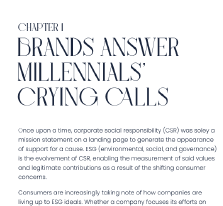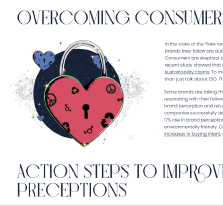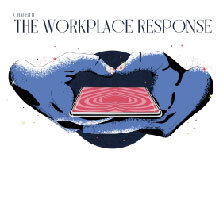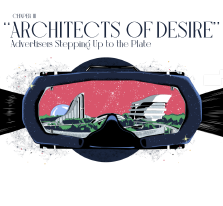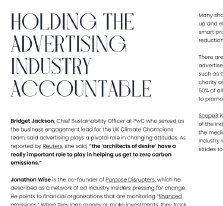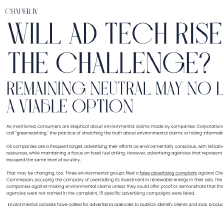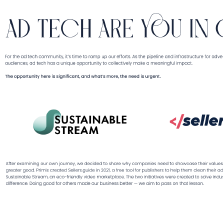CHAPTER III
“ARCHITECTS OF DESIRE”
Advertisers Stepping Up to the Plate
.png)
SERIOUS SOUL-SEARCHING FOR ADVERTISERS AND AGENCIES
Emotions have always played a significant role in advertising; they are pivotal forces that draw people in, evoke visceral reactions, and motivate action. For years, ads have tapped into emotion banks by selling fear. Warnings of what’s to come if we aren’t registered with the correct auto insurance or home owner’s insurance in case of an untimely and detrimental disaster. Ads about deodorant and mouthwash warn viewers that their body odor or bad breath will diminish their chances of finding potential suitors, socially outcasting them from the parameters of society.
"They play on our inherent fears of the unknown or that something is going to kill us,” said Todd Van Slyke, an advertising educator at the Illinois Institute of Art. “This is why scare tactics are stunningly effective."
Much of the advertising surrounding ESG and climate change has focused on the negative impacts and dire consequences of these significant causes. While this has raised awareness, it has also led to feelings of powerlessness among many consumers. Solitaire Townsend, Co-founder of Futerra, a creative agency focused on sustainability, said advertising is too often selling destruction, whether admonishing the continual use of fossil fuels or rebuking fast fashion.
Let's keep in touch
AN OPPORTUNITY TO ENGAGE AND INSPIRE
"Some of the most creative, inventive, persuasive people come into this industry,” said Townsend during the COP26 UN Climate talks in Glasgow in November, 2021. The creativity that exists in the advertising world establishes an “incredible ability to engage and inspire people with climate solutions.”
Advertising has the power to lead change, moving from messages of death and destruction to inspiring solutions and providing hope.
Townsend emphasized that there is a clear market for such action. She cited a joint Futerra and Ipsos study of more than 20,000 consumers in wealthy and developing nations, which revealed that more than three-quarters of consumers care about climate change. Yet, fatalism is often at the core of consumer thinking. Reuters reports that 11% of people think there is no viable solution to climate change. The number rises to 20% when you segment those under age 35, with 66% sharing pessimistic feelings towards the reduction of greenhouse gases.
The numbers are even worse in many other countries. In India, for example, 50% of those surveyed do not believe it’s possible to cut emissions enough to solve the problem.
PERCEPTIONS MUST BE CHANGED
To impact change, perception must be changed. “If we make people fatalistic about climate change, they simply will not act,” said Ben Page, CEO of Ipsos. “Our research shows how the media contribute to an entirely fatalistic narrative — and inaction. The lesson is that if we want to encourage action on climate change, we need to focus on solutions more than terrifying people about an existential threat.” If a mission is doomed to fail, no further action is required. Any calls to action are seemingly negated by helplessness.
Fatalism can become a self-fulfilling prophecy. As a global society, we now need to obsess about the solutions.
Solitaire Townsend
CHAPTER III
“ARCHITECTS OF DESIRE”
Advertisers Stepping Up to the Plate
.png)
SERIOUS SOUL-SEARCHING FOR ADVERTISERS AND AGENCIES
Emotions have always played a significant role in advertising; they are pivotal forces that draw people in, evoke visceral reactions, and motivate action. For years, ads have tapped into emotion banks by selling fear. Warnings of what’s to come if we aren’t registered with the correct auto insurance or home owner’s insurance in case of an untimely and detrimental disaster. Ads about deodorant and mouthwash warn viewers that their body odor or bad breath will diminish their chances of finding potential suitors, socially outcasting them from the parameters of society.
"They play on our inherent fears of the unknown or that something is going to kill us,” said Todd Van Slyke, an advertising educator at the Illinois Institute of Art. “This is why scare tactics are stunningly effective."
Much of the advertising surrounding ESG and climate change has focused on the negative impacts and dire consequences of these significant causes. While this has raised awareness, it has also led to feelings of powerlessness among many consumers. Solitaire Townsend, Co-founder of Futerra, a creative agency focused on sustainability, said advertising is too often selling destruction, whether admonishing the continual use of fossil fuels or rebuking fast fashion.
Let's keep in touch
AN OPPORTUNITY TO ENGAGE AND INSPIRE
"Some of the most creative, inventive, persuasive people come into this industry,” said Townsend during the COP26 UN Climate talks in Glasgow in November, 2021. The creativity that exists in the advertising world establishes an “incredible ability to engage and inspire people with climate solutions.”
Advertising has the power to lead change, moving from messages of death and destruction to inspiring solutions and providing hope.
Townsend emphasized that there is a clear market for such action. She cited a joint Futerra and Ipsos study of more than 20,000 consumers in wealthy and developing nations, which revealed that more than three-quarters of consumers care about climate change. Yet, fatalism is often at the core of consumer thinking. Reuters reports that 11% of people think there is no viable solution to climate change. The number rises to 20% when you segment those under age 35, with 66% sharing pessimistic feelings towards the reduction of greenhouse gases.
The numbers are even worse in many other countries. In India, for example, 50% of those surveyed do not believe it’s possible to cut emissions enough to solve the problem.
PERCEPTIONS MUST BE CHANGED
To impact change, perception must be changed. “If we make people fatalistic about climate change, they simply will not act,” said Ben Page, CEO of Ipsos. “Our research shows how the media contribute to an entirely fatalistic narrative — and inaction. The lesson is that if we want to encourage action on climate change, we need to focus on solutions more than terrifying people about an existential threat.” If a mission is doomed to fail, no further action is required. Any calls to action are seemingly negated by helplessness.
Fatalism can become a self-fulfilling prophecy. As a global society, we now need to obsess about the solutions.
Solitaire Townsend
.svg)
.svg)
.jpg)
